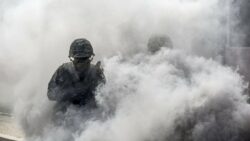Aerojet Rocketdyne Holdings
Aerojet Rocketdyne Holdings, Inc. is an esteemed American company with a significant legacy in the aerospace and defense industry. Founded over a century ago, it has evolved into a key manufacturer of rocket and missile propulsion systems. The company's expertise spans a broad range of applications, from tactical and strategic missile systems to space launch vehicles and in-space propulsion. With a focus on innovation and reliability, Aerojet Rocketdyne Holdings has supplied products that are integral to national security and space exploration. It operates through its subsidiaries, primarily Aerojet Rocketdyne, Inc., which is responsible for the design, development, and production of advanced propulsion systems. The company's strategic direction and technological advancements continue to solidify its role as a crucial contributor to defense and space initiatives.

Key Takeaways
- Aerojet Rocketdyne Holdings is a U.S. manufacturer in the aerospace and defense industries.
- Workers at Aerojet Rocketdyne Holdings were exposed to asbestos due to its involvement in rubber manufacturing and weapon manufacturing.
- Asbestos-related diseases eligible for compensation include various cancers and non-cancerous pleural diseases.
- Family members of Aerojet Rocketdyne Holdings workers have a significant risk of developing diseases due to secondary asbestos exposure.
Company Overview
Aerojet Rocketdyne Holdings, established in 1915, is a prominent aerospace and defense manufacturer with a history that spans over a century. Originally a rubber producer, the company has significantly expanded its reach, demonstrating robust company growth by venturing into the realms of rocket propulsion and armament systems. Its legacy of innovation is evident in its current projects, which include developing advanced propulsion systems for space exploration and national defense. Aerojet Rocketdyne is at the forefront of creating technologies that propel both manned and unmanned flights into space, while also contributing to missile defense initiatives. These endeavors underscore the company's commitment to maintaining a leading position in the industry and to supporting the nation's strategic military and space objectives.
Founding and Evolution
Established in 1915 within the rubber industry, Aerojet Rocketdyne Holdings has since transitioned through various sectors, including broadcasting and aeronautics, to become a leader in aerospace and defense technologies. The company's founding history is deeply rooted in Akron, Ohio, which was pivotal during its initial expansion phase. Over time, the company leveraged its expertise in materials technology and engineering to forge a new path in rocketry and propulsion systems. This Akron expansion laid the groundwork for Aerojet Rocketdyne to evolve into a key player in the defense sector, providing innovative solutions for space and missile systems. The company's adaptability and strategic shifts have cemented its place in the annals of American industrial progress.
Asbestos in Manufacturing
During its years of operation in various manufacturing sectors, Aerojet Rocketdyne Holdings utilized materials containing asbestos, posing health risks to workers and their families. The asbestos exposure risks were significant due to its prevalent use in insulation, gaskets, and as a component in various industrial applications. These risks were not immediately apparent; the long-term health effects of asbestos exposure can take decades to manifest and are often severe. Diseases such as mesothelioma, lung cancer, and other respiratory conditions are closely linked to asbestos exposure. Workers in direct contact with asbestos-containing materials and those in the vicinity faced these hazards, which have since prompted changes in manufacturing practices and increased scrutiny on the use of hazardous materials.
Weapon Production Risks
The manufacturing of weaponry at Aerojet Rocketdyne Holdings presented significant health risks to employees due to the use of asbestos in various components and production processes. Specifically, the practice of weapon polishing, which was integral to ensuring the functionality and reliability of the weapons, involved the use of asbestos fibers that posed inhalation dangers. Over time, the health risks associated with such exposure became clear, with workers facing an increased likelihood of developing various asbestos-related diseases. The company's history with asbestos use in weapon production underscores the critical need for stringent safety protocols and monitoring to protect workers from the long-term health risks associated with manufacturing processes involving hazardous materials.
Asbestos in Construction
Within the construction sector of Aerojet Rocketdyne Holdings, asbestos was extensively utilized in building materials, posing significant health risks to workers involved in the construction and maintenance of facilities. Asbestos, once a common component for its heat-resistant properties, has since been recognized for its carcinogenic potential. The inhalation of asbestos fibers can lead to severe lung conditions, including mesothelioma and asbestosis. In response to these health risks, stringent asbestos regulations have been implemented to protect workers and the public from exposure. These regulations require proper handling, removal, and disposal of asbestos-containing materials. Aerojet Rocketdyne Holdings, like other companies within the industry, must adhere to these safety protocols to mitigate health risks and ensure a safer working environment for its employees.
Affected Occupational Groups
Several occupational groups at Aerojet Rocketdyne Holdings, including aircraft, factory, and rubber factory workers, have historically been at heightened risk for asbestos exposure due to the nature of their work. The risks of occupational exposure were often under-recognized, leading to insufficient protection for those handling asbestos materials. Asbestos, once a common component in various industrial applications, has been linked to serious long-term health effects, including respiratory diseases and cancer. For these workers, the latency period between exposure and the onset of symptoms can span decades, complicating the diagnosis and treatment of related conditions. Consequently, current and former employees of Aerojet Rocketdyne Holdings who were part of these at-risk groups may face significant health challenges as a direct result of their occupational environment.
Cancerous Diseases
Exposed to asbestos during their employment at Aerojet Rocketdyne Holdings, workers may develop various cancerous diseases, including lung cancer and mesothelioma, which are known for their latency periods and resistance to early detection. The prolonged period between asbestos exposure and the onset of symptoms poses challenges for cancer prevention strategies. Nonetheless, advancements in medical surveillance and early diagnostic techniques continue to improve outcomes for affected individuals. Furthermore, stringent asbestos regulations have been implemented to minimize the risk of exposure, thereby reducing the incidence of occupational cancers. These regulations mandate proper handling, usage, and disposal of asbestos materials, and necessitate the use of protective equipment and training for employees, ensuring a safer working environment and aiding in the prevention of asbestos-related malignancies.
Eligible Non-Cancerous Conditions
Numerous non-cancerous conditions related to asbestos exposure, such as asbestosis and pleural plaques, may also qualify Aerojet Rocketdyne Holdings employees for compensation. Asbestos, once prevalent in various industries, can cause a range of respiratory ailments beyond the widely recognized cancerous implications. Non-cancerous pleural diseases, including diffuse pleural thickening and pleural effusions, are among the conditions that may develop following prolonged exposure to asbestos fibers. These ailments can lead to significant respiratory compromise and morbidity. Additionally, secondary exposure risks extend to family members who may have encountered asbestos indirectly through contaminated work clothing or equipment. It is crucial for affected individuals to be aware of their rights and potential eligibility for compensation due to these occupational hazards.
Compensation for Families
Reparation for families affected by asbestos-related illnesses at Aerojet Rocketdyne Holdings is a critical aspect of addressing the long-term impacts of occupational exposure. The compensation process is structured to meet stringent legal requirements, ensuring that affected families obtain justice and financial relief. It encompasses compensation for deceased workers' relatives, potentially covering medical bills, lost wages, and funeral costs. Legal assistance is pivotal in navigating the complexities of claims, which must be meticulously documented with employment records, medical diagnoses, and evidence of asbestos exposure. Accurate and timely filing is essential to meet legal deadlines and maximize the potential for a successful claim. The intricate legal landscape demands a thorough understanding of applicable laws and regulations to secure the rightful compensation for these families.
Misdiagnosis Issues
While securing compensation for families is crucial, it is equally important to acknowledge that misdiagnosis is a frequent challenge for workers suffering from asbestos-related diseases due to the subtle and overlapping symptoms with other respiratory conditions. Misdiagnosis challenges are not uncommon, as medical misinterpretation of symptoms can lead to incorrect treatment and a delay in receiving appropriate care for conditions like mesothelioma. Asbestos-related diseases often present symptoms that mimic less severe illnesses, which can lead to a dismissal of the severity of a patient's condition. Accurate diagnosis is vital for effective treatment and plays a crucial role in legal claims. It is essential for medical professionals to consider occupational history when diagnosing respiratory ailments to minimize the risk of medical misinterpretation.
Risks of Secondary Exposure
Secondary asbestos exposure poses a significant risk to family members of Aerojet Rocketdyne Holdings employees, potentially leading to serious health implications. When workers inadvertently carry asbestos fibers on their clothing or equipment, it creates an environment where their loved ones can inhale these carcinogenic materials. Preventing secondary exposure is crucial, particularly by ensuring that employees have access to proper decontamination facilities and follow strict protocols before returning home. Awareness and education about the risks and necessary safety measures can help mitigate these dangers. The long-term health effects of secondary exposure are profound, with diseases such as mesothelioma and lung cancer manifesting years or even decades after initial contact, underscoring the importance of stringent preventative strategies.
Impact on Family Members
The health ramifications for family members of workers at Aerojet Rocketdyne Holdings are significant, as they may suffer from diseases caused by inadvertent asbestos exposure in their domestic environment. Secondary exposure risks are a sobering reality for these households, where asbestos fibers could have been unwittingly introduced by employees coming home from work. Family members, without direct contact with asbestos materials at the workplace, could still inhale or ingest these fibers, leading to severe health issues over time. The potential for medical misdiagnosis is noteworthy, given the latency period of asbestos-related diseases, complicating the clinical picture for those affected. It is crucial for healthcare providers to consider a patient's environmental and familial history when diagnosing conditions that may stem from such indirect asbestos contact.
Filing Wrongful Death Claims
Although the process may be emotionally taxing, initiating a wrongful death claim is a critical step for families seeking justice for loved ones who succumbed to asbestos-related diseases from their time at Aerojet Rocketdyne Holdings. The filing process requires careful documentation, including employment and medical records, along with the death certificate. Legal professionals can guide families through the complexities of determining compensation eligibility, which may cover funeral expenses and past medical bills. It is essential to adhere to the statutory deadlines for filing such claims; hence, timely action is imperative. The ultimate goal is to secure a measure of financial relief and hold responsible parties accountable for the fatal exposure to asbestos.
Seeking Legal Assistance
Numerous individuals affected by asbestos exposure at Aerojet Rocketdyne Holdings may seek legal assistance to pursue compensation claims. Understanding the profound impact on workers' health, these individuals are asserting their legal rights in light of the life-altering illnesses linked to asbestos. Legal professionals specializing in such cases provide essential guidance to navigate the complexities of compensation claims. Their expertise is crucial in establishing a clear connection between the exposure at Aerojet Rocketdyne and the resulting medical conditions. Affected workers and their families are encouraged to promptly consult with legal experts to ensure that their claims are filed within the statutory deadlines and to maximize the compensation they are entitled to for the harm suffered.

This post has been generated by AI and was not reviewed by editors. This is Not legal advice. Please consult with an attorney.



